Hybrid Biological Warfare
The topic of US development of biological weapons under the guise of research is already covered quite extensively in the international press. The historical precedents of the use of biological and chemical agents by the US against other countries are usually pointed out. Plans against the Republic of Cuba, for example. From declassified documents, it is known that the Deputy Assistant Secretary of Defense for Special Operations, General Edward Lansdale, submitted in February 1962 a plan codenamed Task 33, which considered the use of chemical and biological weapons against Cuba. The document stated that “the objective was to devise a plan to incapacitate a large proportion of the sugar workers through the covert use of biological weapons or chemical weapons agents.”[i]
Lansdale proposed poisoning Cuban sugar workers during harvest time by using “non-lethal insect-borne biological weapons” agents. The US Navy was to carry out a biological attack. Lansdale noted that Robert Edwards at Fort Detrick, Maryland, and Cornelius Roosevelt at the CIA would provide information on biological weapons for the proposed operation.[ii]
More recent is the activities of biolaboratories in Georgia and Ukraine, which worked under Pentagon programmes. Although mostly referring to work in the 2000s, the roots of these activities go much deeper.
The Joint Threat Reduction Programme was initiated by the US government, working in cooperation with the Pentagon and the CIA. The Pentagon unit itself was originally called the Department of Defense Special Weapons Agency, and then there was a name change. The Defence Threat Reduction Agency (DTRA) and the US Army Medical Research Institute for Infectious Diseases emerged. The supposed purpose of the programme was to eliminate Soviet nuclear, chemical and biological weapons stockpiles, effectively giving the US control of former Soviet biological weapons.
BioPrepWatch.com wrote in 2010 that “deleted web pages show that Obama ordered Ukrainian biolaboratories to develop ‘deadly pathogens.'”[iii]
Thenationalpulse.com pointed out that the article, which also highlighted the work of former Senator Dick Lugar, was additionally included in issue #818 of the US Air Force Outreach Magazine.
Lugar said plans for the facility were discussed in 2005, when he and then-Senator Barack Obama partnered with Ukrainian officials. Lugar and Obama also helped coordinate efforts between US and Ukrainian researchers that year in an effort to study avian flu and help prevent it.
A 2011 report by the U.S. National Academy of Sciences’ Committee on Biosafety Foresight on the Global Expansion of Highly Isolated Biological Laboratories explains how the Odessa laboratory “is responsible for identifying highly dangerous biological pathogens. This laboratory was renovated and technically upgraded to BSL-3 as part of a cooperation agreement between the United States Department of Defense and the Ukrainian Ministry of Health that began in 2005. The cooperation focuses on preventing the spread of technology, pathogens and knowledge that could be used in developing biological weapons,” the report says.
It is explained that “the renovated laboratory serves as a temporary central reference laboratory with a repository (collection of pathogens). According to Ukrainian regulations, it is authorised to work with both bacteria and viruses of the first and second pathogen groups”.
A separate document detailing the network of Ukrainian biolaboratories from the Biological Weapons Prevention Project describes in more detail the range of pathogens with which the institution has conducted research. Among the viruses studied by the laboratory were Ebola and “viruses of pathogenicity group II using virological, molecular, serological and rapid methods”.
In addition, the laboratory provided “specific training for biosafety and biosecurity professionals in the handling of dangerous biological pathogens”.
Vine Kristaudo notes in this regard that it was not just about capturing a stockpile of samples (and specialists trained in pathogen development and research and biological weapons technology) in Russia, but also countries “along the perimeter of Russia’s borders: these include Ukraine, Azerbaijan, Armenia, Georgia, Kazakhstan, Uzbekistan, Kyrgyzstan, Moldova and Tajikistan,” before spreading to other parts of Asia and Africa.[iv]
There are different versions of the reasons why the US began to conduct such research outside its own country. One version is that it was done so as not to irritate the public, which reacts very negatively to such projects. In other words, to move the laboratories closer to areas where biological weapons could be used. One way or another, these activities are regulated. Take, for example, the US Department of Defense Instruction 3216.01, dated September 13, 2010, on the use of animals in military tests.
It states that its responsibilities include:
(1) The Office of the Secretary of Defense, the Military Departments, the Office of the Chairman of the Joint Chiefs of Staff and the Joint Staff, the Combatant Commands, the Office of the Inspector General of the Department of Defense, the Department of Defense Agencies, the Department of Defense Field Activity, and all other organizational units within the Department of Defense (collectively, “Department of Defense Components”).
(2) Research, development, testing, and evaluation or training conducted or supported both within and outside the continental United States.
(3) Vertebrate animals, living and dead, including birds, cold-blooded animals, and other specified species of mammals.
To be specific, animals include different species. For example, dogs are classified as ceremonial and service animals. There is a category of farm animals, although it does not only include those that are consumed for food. Those used for disease surveillance are also mentioned. Wild animals may be captured for the needs of the Ministry of Defence. The dictionary also mentions rats and mice, fish and amphibians (with their larvae also considered suitable material for research).
“Dead” is defined as animals killed for the express purpose of research or training. However, it does not include dead animals or parts of dead animals purchased from grocery shops or slaughterhouses.
Paragraph 2 makes it clear that experiments on animals are conducted outside the United States.
But high-risk, high-risk biological research is not solely conducted by the US Department of Defense. It is more correct to say that a powerful network or consortium has been formed that includes other agencies, research centres and laboratories.
The Department of Homeland Security has a National Biodefense Analysis and Countermeasures Center.[vi] This centre is a partner in the National Interagency Biological Research Confederation, which is based at Fort Detrick.
This consortium includes the Centers for Disease Control and Prevention, Food and Drug Administration; National Cancer Institute; National Institute of Allergy and Infectious Diseases Joint Research Center; Naval Medical Research Center Biodefense Research Directorate; US Army Implement Management Command; US Army Medical Research and Material Command; US Army Medical Research Institute for In Plum Island Animal Disease Research Center, Massachusetts, a high-security facility.[vii] It opened in 1954 and was used by the US Army for testing biological weapons.
National Center for Biological and Agricultural Defence, which is also a Tier 4 Biological Site.[viii]
It should be added that the Department of Homeland Security also has a Chemical Security Analysis Centre.[ix]
In addition to the US military, a large number of other contractors are involved in these projects, such as the Technology Management Company (TMC).
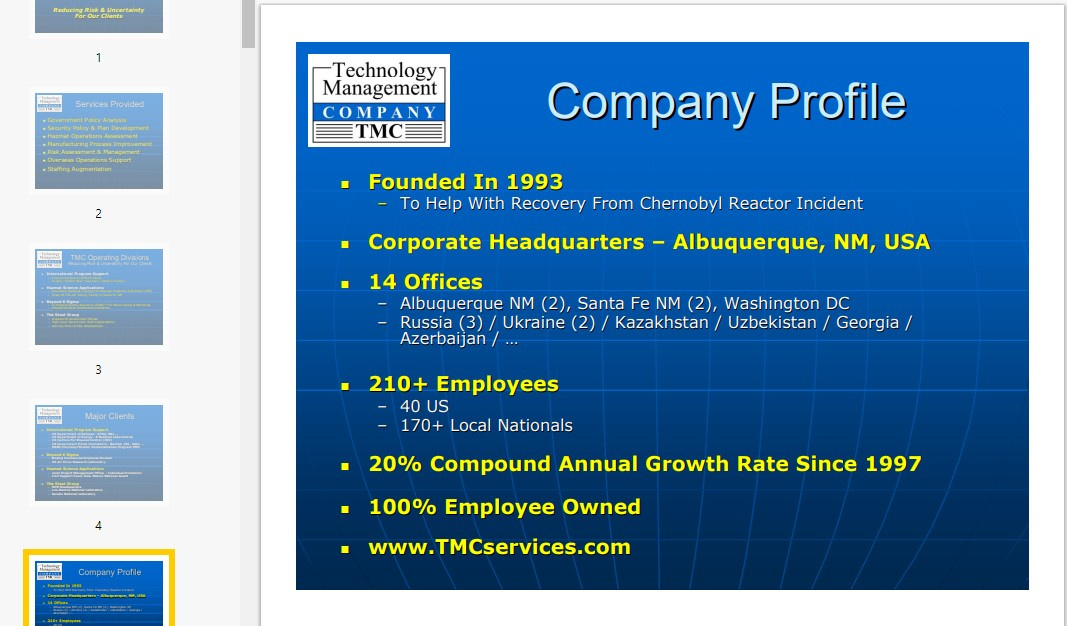
The presentation of TMC projects from the 1990s and early 2000s outlined activities in Uzbekistan, Kazakhstan, Russia and Ukraine related to disarmament and disposal of nuclear and chemical weapons, as well as biological research data collection totalling over $14 million. THE TOTAL VALUE OF THESE ACTIVITIES IS US$14 MILLION.
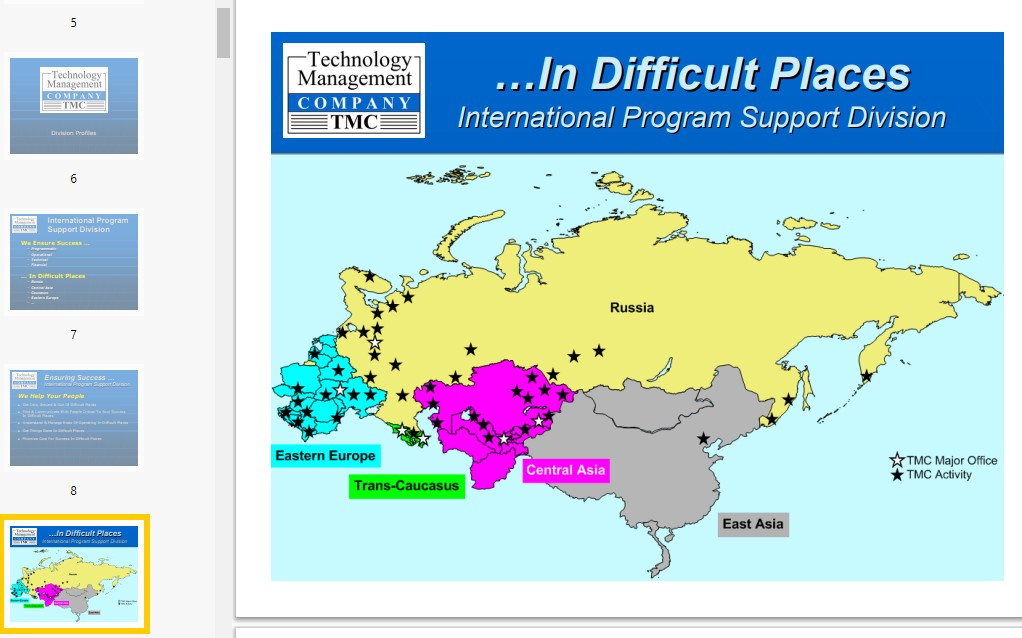
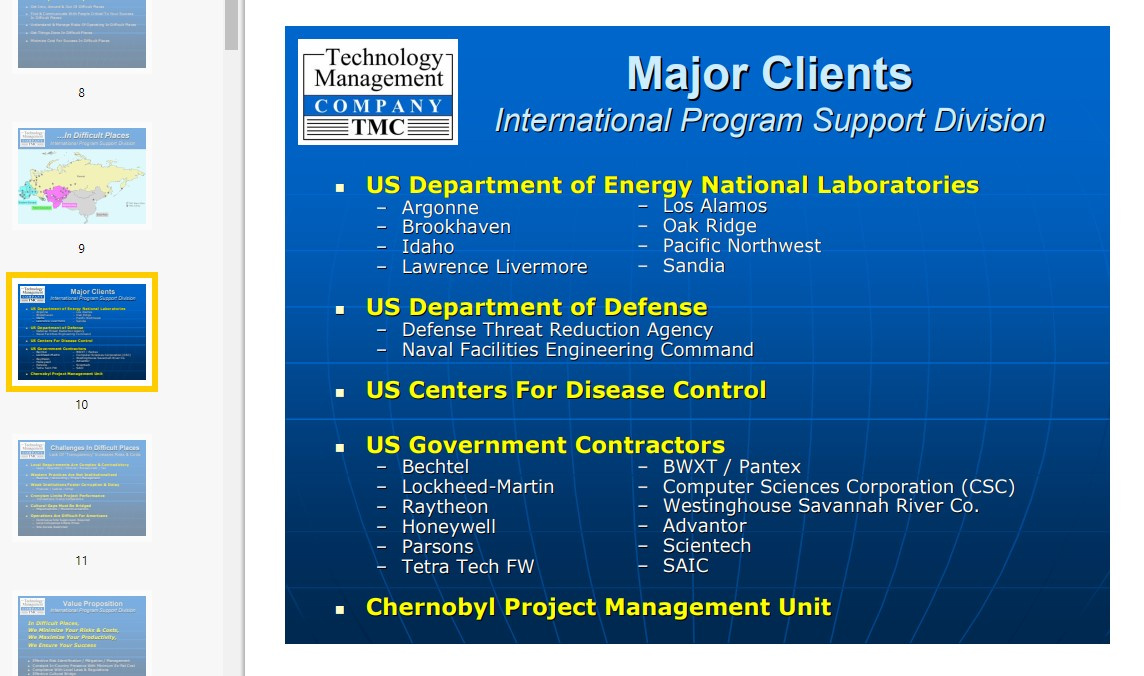
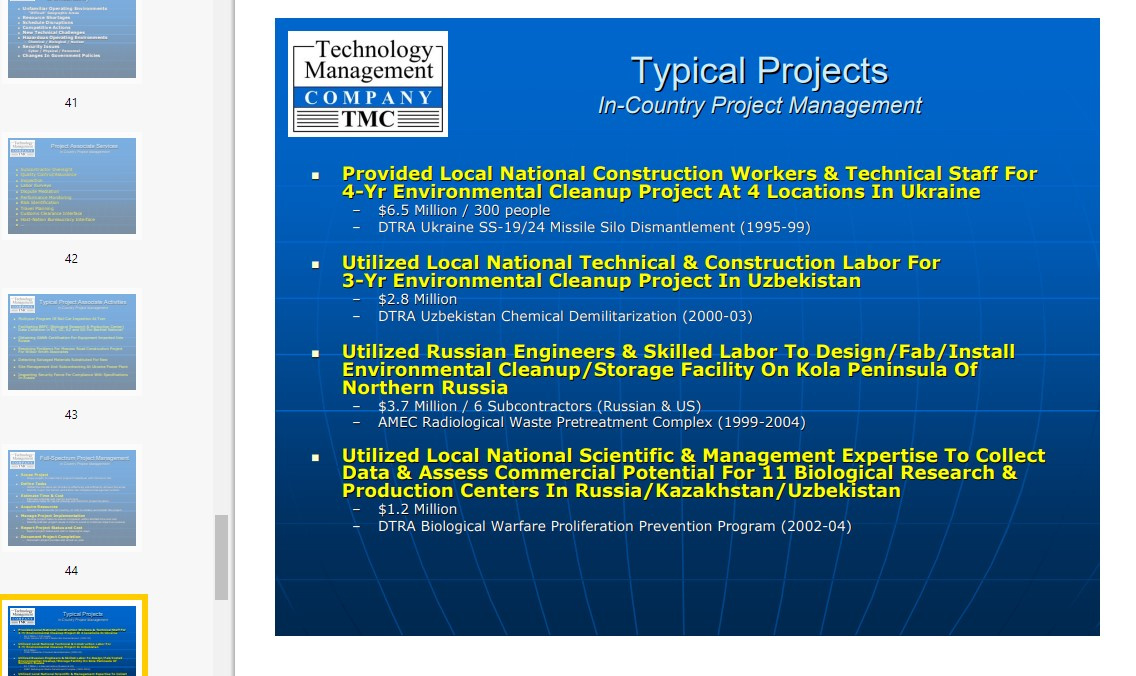

The GG-21 project in Georgia involved using Georgian army personnel (one thousand conscripts) as test subjects for experiments with 14 dangerous pathogens, including anthrax, salmonellosis, tularemia, borreliosis, hemorrhagic fever, bartonellosis and others. Blood sampling during a medical examination and further testing for antibodies against pathogens was assumed. These diseases also include diseases that are not endemic in Georgia, for example, bartonellosis is a tropical infection, which is typical for some Latin American countries (Peru, Ecuador).

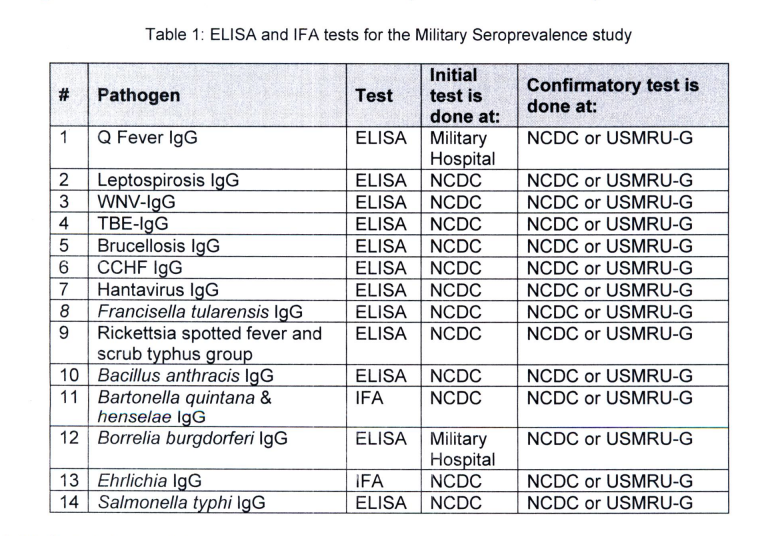
And given the fact that the TMC was involved in recruitment and data analysis, it can be assumed that it was also a front for the work of US intelligence services.
What is interesting, search data shows that the TMC office in Russia was located in Moscow at 7/5 Bolshaya Dmitrovka[x] as well as 25 Leontievsky Lane.[xi]
The addresses of TMS offices in Ukraine can also be found.
DTRA has also awarded Black & Veatch Special Projects Corp. an $80 million contract as part of the Biological Threat Reduction Programme (BTRP) in Ukraine in 2020. Another DTRA contractor working in Ukraine was Englewood, Colorado-based CH2MHill, which previously managed the $5.26 billion Panama Canal expansion project and provided consulting services to manage Iraq’s overall seawater supply project. It was awarded a $22.8 million (2020-2023) contract to renovate and equip two new biolaboratories: the State Research Institute for Laboratory Diagnostics. and Veterinary and Sanitary Expertise (Kyiv region) and the Regional Diagnostic Laboratory of the State Service of Ukraine for Food Safety and Consumer Protection (Odessa region).[xii]
So we see a wider network of different structures that encompass not only biological research.
The activities of private companies related to pharmacology, medicine and biotechnology are also of interest. For example, National Resilience, founded in the US in November 2020, describes itself as “a manufacturing and technology company dedicated to increasing access to complex medicines and protecting biopharmaceutical supply chains from disruption.”[xiii]
Since then, the company has been building “a sustainable network of high-tech integrated manufacturing solutions to ensure fast, secure and scalable production of today’s and tomorrow’s medicines”. It also plans to “reinvent biomechanics” and “democratise access to medicines”, namely gene therapy, experimental vaccines and other “tomorrow’s medicines”.
The company initially positioned its manufacturing capabilities as a “sustainability platform” and offers mainly “RNA methods”, including RNA development for vaccines, gene editing and therapeutics; and “virus production”, including viral vectors, oncolytic viruses (i.e. a virus engineered to preferentially affect cancer cells), viruses for use in vaccine development and genetically modified viruses for undefined purposes.[xiv]
It is worth noting that, to date, many controversial ‘functionality enhancement’ experiments have justified the modification of viruses for the same purposes described in National Resilience’s virus production capabilities.
In April 2021, National Resilience acquired Ology Bioservices Inc. which was awarded a $37 million contract by the US military to develop an advanced treatment with monoclonal antibodies against COVID-19. This acquisition also provided National Resilience with its first Biosafety Level 3 (BSL-3) laboratory and the ability to produce cell and gene therapies, live virus vaccines and vectors, and oncolytic viruses.
In 2022, the company announced several new customers – Takeda, Opus Genetics and the US Department of Defence.[xv]
One of the company’s co-founders was biotech venture capitalist Robert Nelsen, who famously was one of the first investors in Illumina, a California-based gene sequencing hardware and software company. It is now thought to dominate the field of genomics. Illumina is closely associated with the DARPA equivalent of the Wellcome Trust, known as Wellcome Leap, which also focuses on ‘futuristic’ and transhumanist ‘medicines’.
Tellingly, In-Q-Tel CEO Chris Darby sits on Resilience’s board of directors. In-Q-Tel was the first CIA venture capital firm set up to launder money and create “independent” projects. Darby is also on the board of directors of the CIA Officers Memorial Fund.
And the idea for Resilience itself was suggested to Nelsen by Luciana Borio, who was then vice president of In-Q-tel. Prior to In-Q-tel, she served as director of medical and biological defence preparedness at the National Security Council under the Trump administration, and was previously acting chief scientist at the FDA from 2015 to 2017.
Borio is currently a Senior Global Health Fellow at the Council on Foreign Relations, a consultant to Goldman Sachs, a member of the Bill Gates-funded vaccine alliance CEPI, and a partner at Nelsen venture capital firm ARCH Venture Partners.
The emergence of such firms echoes the history of private military companies set up in the US and operating in Iraq and Afghanistan. In this way, the relevant agencies avoid responsibility by shifting it to the private sector. In addition, there are certain gaps in legislation.
There are now many regulations and guidelines concerning laboratory biosafety in the US. Safety training can vary greatly from one institution to another. Experiments with certain pathogens and some research funded by the US government are subject to oversight, but there are some loopholes. If biolabs do not work with the most dangerous pathogens, they do not need to register with the US government registry. As a result, little is known about the biosafety of experiments carried out by private companies or foundations.
“Your favourite tech billionaire could do almost anything he wants with any pathogen for his own money,” said Rocco Casagrande, managing director of the biosafety consulting firm Gryphon Scientific, which advised the US National Institutes of Health on biosafety standards. “They could take a measles virus and deliberately try to make it resistant to vaccines and more pathogenic in their garage. If they’re doing it for legitimate research purposes, in their own mind, they could be doing it wildly, unsafely, and no one could stop them.”[xvi]
Probably all of these words can be applied to the activities of Robert Nelsen’s companies, and others like them.
And so, in late October 2022, US President Joe Biden signed the national biosecurity strategy and implementation plan.[xvii] The strategy itself is a little over ten pages long, but the implementation plan appendix is quite a large document, as long as the US national security strategy. It would seem to put an end to the confusion that has developed in the US. Let’s see if it does.
It specifies three kinds of biological threats: natural, accidental and deliberate. Interestingly, the COVID-19 epidemic, while not directly classified as natural (which already makes one wonder), is listed in this block in the context that it spread fairly rapidly around the world, “directly affecting the US population, their health, safety and welfare”.
It notes that the US recognises the following principles:
- Biological threats persist. Pathogens have emerged and spread throughout history, and the risks posed by these pathogens are becoming more acute as the world becomes more urbanised, travel becomes more frequent, and climate and habitat change. Individual nation states and terrorist groups have seen advantages in developing biological weapons, and there is no certainty that this will change in the future. Advances in the life sciences will both reduce the technological barriers to acquiring such weapons and increase the number of people with the appropriate skills to carry out the threats.
- Biological threats emanate from multiple sources. As part of the biological defence, the United States includes countering both intentional biological threats and threats arising from natural and accidental outbreaks.
- Infectious diseases recognize no borders. An interconnected world increases the emergence, re-emergence and spread of pathogens in such a way that a disease threat anywhere is a disease threat anywhere.
- Biological incidents affect critical infrastructure and supply chains.
- Multisectoral and multi-stakeholder cooperation is crucial for effective biological defence.
This strategy involves whole-of-government and whole-of-society engagement in biological defence, both nationally and globally. Assessment, prevention, preparedness, response and recovery covers various sectors including medicine; human, animal and plant health; emergency response; science and technology; law enforcement; industry; academia; diplomacy; defence and security; intelligence; social and behavioural sciences; strategic risk communication; transport; travel and tourism; and the non-proliferation and counter-proliferation sectors.
- The One Health approach reduces the likelihood of bio-incidents and their impact.
- Science and technology will continue to advance worldwide… Advances in science and technology bring revolutionary treatments and advances, but they also have the potential for deliberate misuse. The United States has a responsibility to ensure that our technologies, developments and assistance programmes do not inadvertently exacerbate this risk.
Michael Nevradakis notes that more than 20 federal agencies will be involved in the administration’s new biological defence strategy, while “oversight of the strategy will be conducted at the White House under the direction of the National Security Advisor.”[xviii]
According to a senior Biden administration official, the new strategy “directs the US intelligence community to monitor threats and ensure that the United States ‘continually adapts to this changing threat landscape’ by conducting annual exercises” to “prevent epidemics and biological incidents before they occur.
This may recall the drills and simulations that took place just before the COVID-19, monkeypox and anthrax outbreaks, which seemed to predict with striking similarity what was to follow.
In other words, if there is any exercise on the subject of bio-threat by US authorities, it is highly likely that another epidemic of a dangerous disease will occur. In other words, first manoeuvres and then war, albeit in a slightly different form than everyone is used to assessing armed conflict.
Defense One wrote that achieving some of the goals of the “moonshot” strategy “will require expanded data collection efforts at research facilities around the world,” in addition to a significant increase in a host of other research-related efforts, noting that the administration “has not specified which technologies they will use.[xix]
According to this resource, the US may need to develop “new approaches to RNA research” to “alleviate pandemics”, in addition to “new forms of plant-based vaccines” that could “allow vaccine production to increase by orders of magnitude”. But these approaches could also mean creating new viruses.
Although there is scepticism about the implementation of this strategy among US officials themselves. An unnamed Biden administration official quoted by Defense One generally conceded that the “moonshot” envisioned by the plan “is not possible today, but these capabilities can be achieved and are within our reach with the right resources in the next five to ten years.”
Hiring more health workers could also prove a challenge for the Biden administration because of the shortage of nurse practitioners, which is expected to grow by 2025, along with the looming “shortage of other health workers”.
The issue is not just a lack of qualified professionals, but also the degradation of the overall situation. A 5,500-page report by the National Institutes of Health, including 18 years of laboratory incident data, details hundreds of virus-related accidents.
The documents show that such incidents occur even in highly secure BSL-3 and BSL-4 laboratories and that in some cases they lead to infection. For example, a graduate student at Washington University School of Medicine contracted the chikungunya virus by pricking her finger with a needle. Documents also show that a researcher working with antibiotic-resistant MRSA bacteria in a Food and Drug Administration laboratory has been infected.[xx]
However, while disruption of parts of the civilian sector strategy is quite possible (and would directly affect the welfare of American citizens), it is unlikely that the military would allow them to be cut funding for any programmes they already run or plan to run, including overseas initiatives related to research into high-risk, dangerous pathogens.
Francis Boyle, a lawyer and professor of international law at the University of Illinois, who co-authored the Bioterrorism Act of 1989 in the US on biosafety strategy, considers “the development, promotion and implementation of dual-use research and research involving potentially pandemic and other high consequence pathogens to be of concern.[xxi] Boyle believes the very wording of the Biden Executive Order is an egregious illicit violation.
Boyle himself is quite aware of the ways in which biological weapons have been developed, and in an interview he mentions South Africa’s role in such activities, which began with the CIA conducting research, development and stockpiling of biological weapons with the assistance of the apartheid regime, and the BSL-4 laboratory in the country now continuing work on “reprehensible biological warfare weapons”.
Incidentally, Boyle is among those experts who believe the coronavirus is of artificial origin. He believes it was done deliberately, to reduce the population, especially from third world countries.
Boyle has also previously stated openly that the US is deliberately setting up bio-labs in countries near Russia in order to use biological weapons against Russia.[xxii]
Given that Boyle collected indictment material against Slobodan Milosevic, he can hardly be called a friend of Russia. Simply, as an unbiased professional, he describes the situation as it is and speaks of the risks of further trends.
As we can see, he has real grounds for this. And, unlike conventional weapons, biological agents can hit their own hosts.
The US Pentagon weapons and strategy expert William Hartung, in his publication on the military-industrial lobby, calls the arms sales policy nothing short of “The US Hall of Shame.”[xxiii] Apparently, it is time to open a second such hall dedicated to biological research on dubious pretexts.
References:
[ii]https://www.archives.gov/files/research/jfk/releases/docid-32424914.pdf
[iv]https://www.thepostil.com/lies-spies-and-us-bioweapons-on-the-verge-of-armageddon/
[v]https://bids.iwtsd.gov/Resource/DisplayRE
[vi]https://www.dhs.gov/science-and-technology/national-biodefense-analysis-and-countermeasures-center
[vii]https://www.dhs.gov/science-and-technology/plum-island-animal-disease-center
[viii]https://www.dhs.gov/science-and-technology/national-bio-and-agro-defense-facility
[ix] https://www.dhs.gov/science-and-technology/csac
[x] https://moscow.orgsinfo.ru/company/1986117-technology-management-company#work_hours
[xi] https://www.k-agent.ru/catalog/9909182805-0
[xiv]https://web.archive.org/web/20210411062128/https://resilience.com/capabilities/
[xvi]https://theintercept.com/2022/11/01/biosafety-lab-accident-chikungunya-virus/
[xviii]https://childrenshealthdefense.org/defender/biological-weapons-biden-biodefense-strategy/
[xxi]https://www.biznews.com/health/2022/10/20/bioweapons-pandemics
[xxii]https://expose-news.com/2022/04/11/us-funded-bioweapons-ukraine-use-against-russia/
[xxiii]https://tomdispatch.com/corporate-weapons-heaven-is-a-hell-on-earth/







